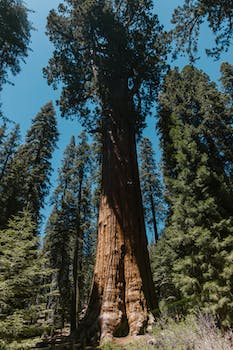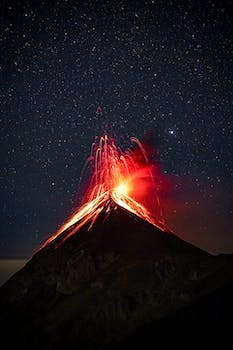

-
Table of Contents
The Mighty Sequoia: America's Towering Giant
Introduction
The Mighty Sequoia: America's Towering Giant is an introduction to the majestic and awe-inspiring Sequoia trees found in the United States. These towering giants are renowned for their immense size, longevity, and ecological significance. This article explores the unique characteristics, historical significance, and conservation efforts surrounding the mighty Sequoia trees, providing readers with a glimpse into the world of these remarkable natural wonders.
The History and Significance of The Mighty Sequoia
The Mighty Sequoia: America's Towering Giant
The history and significance of the mighty sequoia are deeply rooted in the rich tapestry of America's natural heritage. These towering giants, also known as giant sequoias or Sequoiadendron giganteum, are native to the western slopes of the Sierra Nevada mountain range in California. They have captivated the imagination of people for centuries, and their majestic presence continues to inspire awe and wonder.
The story of the mighty sequoia begins millions of years ago, during the Jurassic Period. It was a time when dinosaurs roamed the Earth, and the climate was warm and humid. In this ancient landscape, the sequoias began to take root. Over time, they adapted to the changing environment and developed unique characteristics that allowed them to thrive in the harsh conditions of the Sierra Nevada.
The first recorded encounter with the giant sequoias by Europeans occurred in 1833 when a hunter named Joseph Reddeford Walker stumbled upon them while exploring the region. He was astounded by their size and beauty, and word of these magnificent trees quickly spread. However, it wasn't until the 1850s that the giant sequoias gained widespread attention.
During this time, California was experiencing a gold rush, and people from all over the world flocked to the state in search of fortune. As they made their way through the Sierra Nevada, they marveled at the towering sequoias. Some even tried to cut them down to use the wood for building materials. Recognizing the need to protect these ancient giants, concerned citizens and conservationists began advocating for their preservation.
In 1864, President Abraham Lincoln signed the Yosemite Grant Act, which protected the Yosemite Valley and Mariposa Grove, home to some of the largest and oldest sequoias. This marked the first time in history that a government had set aside land specifically for preservation purposes. It was a significant milestone in the conservation movement and laid the foundation for future efforts to protect America's natural wonders.
The significance of the mighty sequoia extends beyond their historical and cultural importance. These trees play a vital role in the ecosystem, providing habitat for a diverse range of plant and animal species. Their massive trunks can reach diameters of up to 30 feet, and their bark is incredibly thick, acting as a natural fire barrier. This adaptation allows them to withstand wildfires that would destroy most other trees.
Additionally, the giant sequoias are among the oldest living organisms on Earth. Some have been estimated to be over 3,000 years old, making them witnesses to countless generations of human history. Their longevity serves as a reminder of the resilience and endurance of nature.
Today, efforts to protect and preserve the mighty sequoia continue. National parks such as Sequoia and Kings Canyon provide a sanctuary for these majestic trees, allowing visitors to experience their grandeur firsthand. Scientists and researchers are also studying the sequoias to better understand their unique biology and develop strategies for their long-term conservation.
In conclusion, the history and significance of the mighty sequoia are intertwined with America's natural heritage. These towering giants have captured the imagination of people for centuries and continue to inspire awe and wonder. From their ancient origins to their role in the ecosystem, the giant sequoias are a testament to the power and beauty of nature. As we strive to protect and preserve these magnificent trees, we honor their legacy and ensure that future generations can marvel at their towering presence.
Exploring the Unique Characteristics of The Mighty Sequoia

The Mighty Sequoia: America's Towering Giant
Exploring the Unique Characteristics of The Mighty Sequoia
The mighty sequoia, also known as the giant sequoia or Sequoiadendron giganteum, is one of the most awe-inspiring trees in the world. Native to the western slopes of the Sierra Nevada mountains in California, these towering giants have captured the imagination of people for centuries. In this article, we will explore the unique characteristics that make the mighty sequoia truly remarkable.
First and foremost, the size of the mighty sequoia is truly astounding. These trees can reach heights of over 300 feet, making them some of the tallest trees on the planet. In fact, the tallest known sequoia, named Hyperion, stands at a staggering 379.7 feet tall. To put that into perspective, that's taller than the Statue of Liberty! Not only are they tall, but they also have massive trunks that can measure up to 40 feet in diameter. These enormous dimensions make the mighty sequoia a true giant among trees.
Another unique characteristic of the mighty sequoia is its incredible lifespan. These trees can live for thousands of years, with some specimens estimated to be over 3,000 years old. This longevity is due in part to their thick bark, which can be up to three feet thick. This bark acts as a natural fire shield, protecting the tree from wildfires that are common in their native habitat. Additionally, the mighty sequoia has a remarkable ability to regenerate itself. When a sequoia is damaged or cut down, it can sprout new growth from its base, ensuring its survival for generations to come.
The mighty sequoia is also known for its unique reproductive strategy. Unlike most trees, which rely on wind or animals to disperse their seeds, the sequoia has cones that are specifically adapted to release their seeds in response to fire. When a fire sweeps through a sequoia grove, it opens the cones and releases thousands of seeds onto the newly cleared forest floor. The heat from the fire also helps to create the ideal conditions for the seeds to germinate and grow. This adaptation ensures that the mighty sequoia can thrive in its fire-prone environment.
In addition to their impressive size and longevity, the mighty sequoia also plays a vital role in the ecosystem. These trees provide habitat for a wide variety of species, including birds, mammals, and insects. The thick bark of the sequoia also provides a unique microhabitat for many organisms, including lichens and mosses. Furthermore, the mighty sequoia is an important carbon sink, absorbing and storing large amounts of carbon dioxide from the atmosphere. This makes them a crucial ally in the fight against climate change.
In conclusion, the mighty sequoia is a truly remarkable tree with unique characteristics that set it apart from all others. From its towering height and massive trunk to its incredible lifespan and reproductive strategy, the sequoia is a testament to the wonders of the natural world. Not only do these trees inspire awe and wonder, but they also play a vital role in the ecosystem and contribute to the fight against climate change. The mighty sequoia truly deserves its title as America's towering giant.
Conservation Efforts to Protect The Mighty Sequoia
The mighty sequoia, also known as the giant sequoia or Sequoiadendron giganteum, is one of the most iconic trees in America. These towering giants can reach heights of up to 300 feet and have a lifespan of over 3,000 years. However, despite their impressive stature and longevity, the mighty sequoias are facing numerous threats that put their survival at risk. In response to these challenges, conservation efforts have been implemented to protect these majestic trees and ensure their preservation for future generations.
One of the primary threats to the mighty sequoia is habitat loss. Historically, these trees covered a vast area of the western United States, but due to logging and urbanization, their range has significantly diminished. Today, the majority of sequoia groves are confined to protected areas such as national parks and reserves. These protected areas serve as havens for the mighty sequoias, shielding them from further destruction and providing a safe environment for their growth and reproduction.
In addition to habitat loss, climate change poses a significant threat to the mighty sequoia. Rising temperatures and changing precipitation patterns can have detrimental effects on these trees. Sequoias rely on a specific set of environmental conditions to thrive, including cool temperatures and ample water supply. As the climate changes, these conditions may become less favorable, making it difficult for the sequoias to survive. To mitigate the impact of climate change, conservationists are working to reduce greenhouse gas emissions and promote sustainable practices that help preserve the unique ecosystems where the mighty sequoias reside.
Another crucial aspect of conservation efforts is the prevention of wildfires. While fire is a natural part of the sequoia ecosystem and can even benefit the trees by clearing out competing vegetation, the increasing frequency and intensity of wildfires in recent years have become a cause for concern. Uncontrolled fires can destroy entire groves of sequoias, wiping out centuries-old trees in a matter of hours. To protect the mighty sequoias from wildfires, prescribed burns and other fire management techniques are employed to reduce fuel loads and create firebreaks. These measures help maintain a healthy balance between fire and the sequoia ecosystem, ensuring the long-term survival of these magnificent trees.
Furthermore, conservation efforts also involve public education and outreach programs. Many organizations and national parks have developed educational initiatives to raise awareness about the importance of sequoia conservation. These programs aim to instill a sense of stewardship and responsibility among visitors, encouraging them to appreciate and protect these natural wonders. By fostering a connection between people and the mighty sequoias, these initiatives help create a collective effort to safeguard these towering giants.
In conclusion, the mighty sequoia faces numerous threats to its survival, including habitat loss, climate change, and wildfires. However, through dedicated conservation efforts, these majestic trees are being protected and preserved. By establishing protected areas, mitigating the impact of climate change, managing wildfires, and promoting public education, conservationists are working tirelessly to ensure the long-term survival of the mighty sequoia. These efforts are crucial in safeguarding not only a symbol of American natural heritage but also a testament to the resilience and beauty of the natural world.
Q&A
1. What is the height of a fully grown Mighty Sequoia?
The height of a fully grown Mighty Sequoia can reach up to 280 feet (85 meters).
2. Where can you find the Mighty Sequoia in the United States?
The Mighty Sequoia is primarily found in the Sierra Nevada mountain range in California, United States.
3. How long can a Mighty Sequoia live?
Mighty Sequoias have an average lifespan of around 2,000 to 3,000 years.
Conclusion
In conclusion, the Mighty Sequoia is a towering giant that holds great significance in America. Its impressive size, longevity, and ecological importance make it a symbol of strength and resilience. The preservation and conservation of these majestic trees are crucial to maintaining the balance of our ecosystems and preserving the natural beauty of our country.












